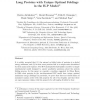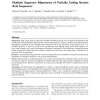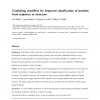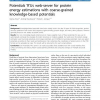93
Voted
CORR
2002
Springer
15 years 15 days ago
2002
Springer
It is widely accepted that (1) the natural or folded state of proteins is a global energy minimum, and (2) in most cases proteins fold to a unique state determined by their amino ...
107
Voted
BMCBI
2005
15 years 18 days ago
2005
Background: High quality sequence alignments of RNA and DNA sequences are an important prerequisite for the comparative analysis of genomic sequence data. Nucleic acid sequences, ...
BMCBI
2006
15 years 22 days ago
2006
Background: Predicting residues' contacts using primary amino acid sequence alone is an important task that can guide 3D structure modeling and can verify the quality of the ...
94
Voted
BMCBI
2006
15 years 22 days ago
2006
Background: Designing novel proteins with site-directed recombination has enormous prospects. By locating effective recombination sites for swapping sequence parts, the probabilit...
127
click to vote
BMCBI
2006
15 years 22 days ago
2006
Background: Despite the current availability of several hundreds of thousands of amino acid sequences, more than 36% of the enzyme activities (EC numbers) defined by the Nomenclat...
110
click to vote
BMCBI
2007
2007
Application of amino acid occurrence for discriminating different folding types of globular proteins
15 years 24 days ago
Background: Predicting the three-dimensional structure of a protein from its amino acid sequence is a long-standing goal in computational/molecular biology. The discrimination of ...
113
click to vote
BMCBI
2008
15 years 24 days ago
2008
Background: The process of horizontal gene transfer (HGT) is believed to be widespread in Bacteria and Archaea, but little comparative data is available addressing its occurrence ...
104
Voted
BMCBI
2008
15 years 24 days ago
2008
Background: Predicting a protein's structural or functional class from its amino acid sequence or structure is a fundamental problem in computational biology. Recently, there...
92
Voted
BMCBI
2010
15 years 24 days ago
2010
Background: Knowledge-based potentials have been widely used in the last 20 years for fold recognition, protein structure prediction from amino acid sequence, ligand binding, prot...
115
click to vote
HICSS
1994
IEEE
15 years 4 months ago
1994
IEEE
A method is described for identification and classification of proteins encoded in large DNA sequences. Previously, an automated system was introduced for the general detection of...






